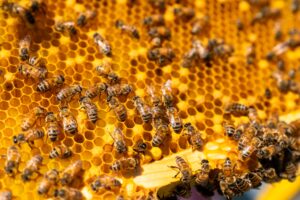Eating the crusts may not make your hair curly, but it turns out B vitamins can help reduce stress.
Kathleen Mikkelsen is from the University of Victoria’s College of Health and Biomedicine. She was part of a team that surveyed 520 people from Australia, New Zealand and the UK.
Participants listed the amount of B vitamin-rich, yeast-based spreads in their diet, such as Vegemite, Marmite, AussieMite and Promite. This information was then combined with their personal rankings of depression and anxiety.
“The people who ate these foods regularly reported lower anxiety and stress scores,” Kathleen says.
This is important research, with more than 2 million Australian’s currently experiencing depression or anxiety.
B-b-bounce
High levels of B vitamins are found in brewers’ yeast extract, the byproduct that makes up Vegemite (and other yeast-based spreads).

The spreads doing the best job are the salt-reduced versions, which have lots of B6, B9 and B12 in them.
“These particular B vitamins have a mechanistic effect on stress anxiety and depression pathways,” Kathleen says.
There are eight types of B vitamins in all, and five of these—B1, B3, B6, B9 and B12—are essential for the health of your nervous system.
Vitamin B helps the body make and properly use neurotransmitters such as dopamine and serotonin. If these neurotransmitters don’t function properly, stress can be triggered.
B vitamins also help with energy production, DNA synthesis and immune function.
It’s not just Vegemite that can put a pep in your step. Kathleen says B vitamins are found in a variety of foods.
“These include whole grains, milk products, eggs, meat, vegetables, legumes, soy products and seeds.”
This is good news to those who are less inclined towards our iconic salty spread.

A health history
Our love affair with Vegemite isn’t new. We’ve been spreading the strange black goop on toast for years now.
Vegemite was used as a health food in the early 1900s when it was included in soldiers’ ration packs during the Great War.
“It seems that right back in WW1 there was a knowledge that vitamin B could help with energy production and had a positive effect on mood,” Kathleen says.
The spread then danced into kitchens around the country with the iconic happy little Vegemites jingle.
Kathleen says that, although it’s clear that vitamin B plays a role in mood, more research is needed.
“Vitamin B cannot replace medication for depression but could be used as an adjunct treatment,” she says.
The study was done at the Centre for Chronic Disease, Victoria University, under the supervision of Professor Vasso Apostolopoulos.








